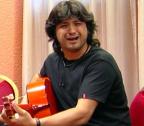Welcome to one of the most active flamenco sites on the Internet. Guests can read most posts but if you want to participate click here to register.
This site is dedicated to the memory of Paco de Lucía, Ron Mitchell, Guy Williams, Linda Elvira, Philip John Lee, Craig Eros, Ben Woods, David Serva and Tom Blackshear who went ahead of us.
We receive 12,200 visitors a month from 200 countries and 1.7 million page impressions a year. To advertise on this site please contact us.
|

|
|
RE: Tuning our guitars
|
You are logged in as Guest
|
|
Users viewing this topic: none
|
|
Login  | |
|

   
Richard Jernigan
Posts: 3430
Joined: Jan. 20 2004
From: Austin, Texas USA

|
 RE: Tuning our guitars (in reply to Ricardo) RE: Tuning our guitars (in reply to Ricardo)
|
|
|
Great video Ricardo! Over the years I've read or been told a lot of stuff about tuning a guitar. I ended up tuning mine the way you show here.
The idea of compensation, or so I've been told by a few luthiers, is that as you move up the fretboard, you push the string down further to fret it--so the notes tend to go sharp. The the bridge is set back so the countervailing tendency is to go flat as you go up the fretboard. The setback is a bigger and bigger fraction of the free string length.
Flamenco guitars, with their low action need little or no compensation.
Over the 57 years I've been playing, the setup of classicals has gotten lower and lower, from the insane action heights that Segovia used (and I think Kazuhito Yamashita still uses on his Ramirez, which he plays un-amplified in fairly large rooms) to the more reasonable actions of today, around 4mm max on the 6th string to around 3mm on the first, sometimes even lower. So logically, the compensation setback on classicals should have decreased as well. But the few I have measured have been all over the place.
The lowest action classical I have is set up in the flamenco range. It's the easiest of the classicals to play in tune, even though the maker insists on high tension strings. But as you point out, you still have to be careful how you set your fingers down on the strings, and you may have to push or pull a little as they drift out of tune. I don't remember measuring the compensation, if any.
I have a 1991 Manuel Contreras Sr. "doble tapa" whose bridge is actually set forward about 1 1/2 millimeters. That is, it's 325mm from the nut to the 12th fret and about 323 1/2mm from the 12th fret to the bridge saddle. Action is about 4mm/3mm, but it's still not that hard to play in tune with normal tension strings.
RNJ
|
|
|
|
REPORT THIS POST AS INAPPROPRIATE |
Date Feb. 19 2019 1:37:17
 |
|

   
Richard Jernigan
Posts: 3430
Joined: Jan. 20 2004
From: Austin, Texas USA

|
 RE: Tuning our guitars (in reply to JasonM) RE: Tuning our guitars (in reply to JasonM)
|
|
|
quote:
ORIGINAL: JasonM
I was told that compensating the bridge further back was to counter the strings pulling the bridge forward under tension. So ideally the end result would be an accurate scale length. Then we have intonation adjustments to the saddle and nut. Based on Ricardo’s advice it sounds like the goal should be to get to the scale length correct and that’s it. At least for low action guitars. Beyond that you are robbing Peter to pay Paul with sweetened notes.
The bridge setbacks I have measured have been with strings on, tuned up to A=440Hz. So if the bridge was indeed pulled forward, there still remained a setback of up to 2mm.
Although I imported several Ramirez 1a's to the USA in the '60s and '70s, I sold all of them. I never measured the setback on any of them. They all had very high actions. By the '70s the fretboards were thinned on the bass side above the 12th fret, a feature Jose III ascribed to Segovia.
Richard Brune once told me that in that era the Ramirez 1a fret spacing and bridge setback were designed to mimic the "stretched" octaves of the piano.
The overtones of any vibrating string don't follow the exact harmonic series of octave, fifth, fourth,... This is called "inharmonicity." The overtones go a little sharper than the pure harmonic series as they go up in frequency.
This shows up in the equations when you account for the string's resistance to bending. In the simplest string equation, which predicts pure harmonics, the force that returns the string toward its equilibrium position is pure tension, no resistance to bending.
The inharmonicity of the grand piano's thick steel, bronze-wound bass strings is much greater than the inharmonicity of nylon or gut strings. The fundamentals of the piano's middle and higher notes are tuned sharp to come closer to resonating with the actual overtones of the basses, not with the theoretical harmonics.
Brune didn't think Ramirez' idea was a particularly good one.
...and the inharmonicity of acoustic steel strings is much greater than that of nylon, as kitarist pointed out, which is why you almost always see at least a slanted bridge saddle on steel string acoustic guitars....
Ricardo's definitely right. On the nylon string guitar, we have to rely on our fingers to play in tune, not on any sophisticated technology.
RNJ
|
|
|
|
REPORT THIS POST AS INAPPROPRIATE |
Date Feb. 19 2019 20:32:37
 |
|

   
Richard Jernigan
Posts: 3430
Joined: Jan. 20 2004
From: Austin, Texas USA

|
 RE: Tuning our guitars (in reply to Ricardo) RE: Tuning our guitars (in reply to Ricardo)
|
|
|
I will repeat the story of buying my first guitar at age 19 at Paracho in Mexico. Sr. Ramon Zalapa's store sold office furniture, paint and guitars. He told me he had a workshop employing a few men who made the guitars. After trying out maybe ten instruments I picked the loudest one. It also played in tune. I knew nothing whatsoever about guitars, but being a 19-year old twit I felt obliged to voice an opinion.
After I complimented the guitar, Sr. Zalapa pushed back his straw hat. A broad smile creased his Indian features, showing a handsome gold tooth.
"Pues, to'os no salen igual," he replied. ["They don't all turn out the same."]
When I repeated the tale to Bruce Bannister, the dealer from whom I bought my Romanillos 43 years later, he laughed hilariously for several seconds, then agreed with Sr. Zalapa.
Of course he added that he had played Romanillos throughout his professional concert and teaching career in Europe, and the one in question was one of the four best.
RNJ
|
|
|
|
REPORT THIS POST AS INAPPROPRIATE |
Date Feb. 21 2019 18:36:33
 |
|
 New Messages New Messages |
 No New Messages No New Messages |
 Hot Topic w/ New Messages Hot Topic w/ New Messages |
 Hot Topic w/o New Messages Hot Topic w/o New Messages |
 Locked w/ New Messages Locked w/ New Messages |
 Locked w/o New Messages Locked w/o New Messages |
|
 Post New Thread
Post New Thread
 Reply to Message
Reply to Message
 Post New Poll
Post New Poll
 Submit Vote
Submit Vote
 Delete My Own Post
Delete My Own Post
 Delete My Own Thread
Delete My Own Thread
 Rate Posts
Rate Posts
|
|
|
Forum Software powered by ASP Playground Advanced Edition 2.0.5
Copyright © 2000 - 2003 ASPPlayground.NET |
0.078125 secs.
|


 Printable Version
Printable Version









 New Messages
New Messages No New Messages
No New Messages Hot Topic w/ New Messages
Hot Topic w/ New Messages Hot Topic w/o New Messages
Hot Topic w/o New Messages Locked w/ New Messages
Locked w/ New Messages Locked w/o New Messages
Locked w/o New Messages Post New Thread
Post New Thread